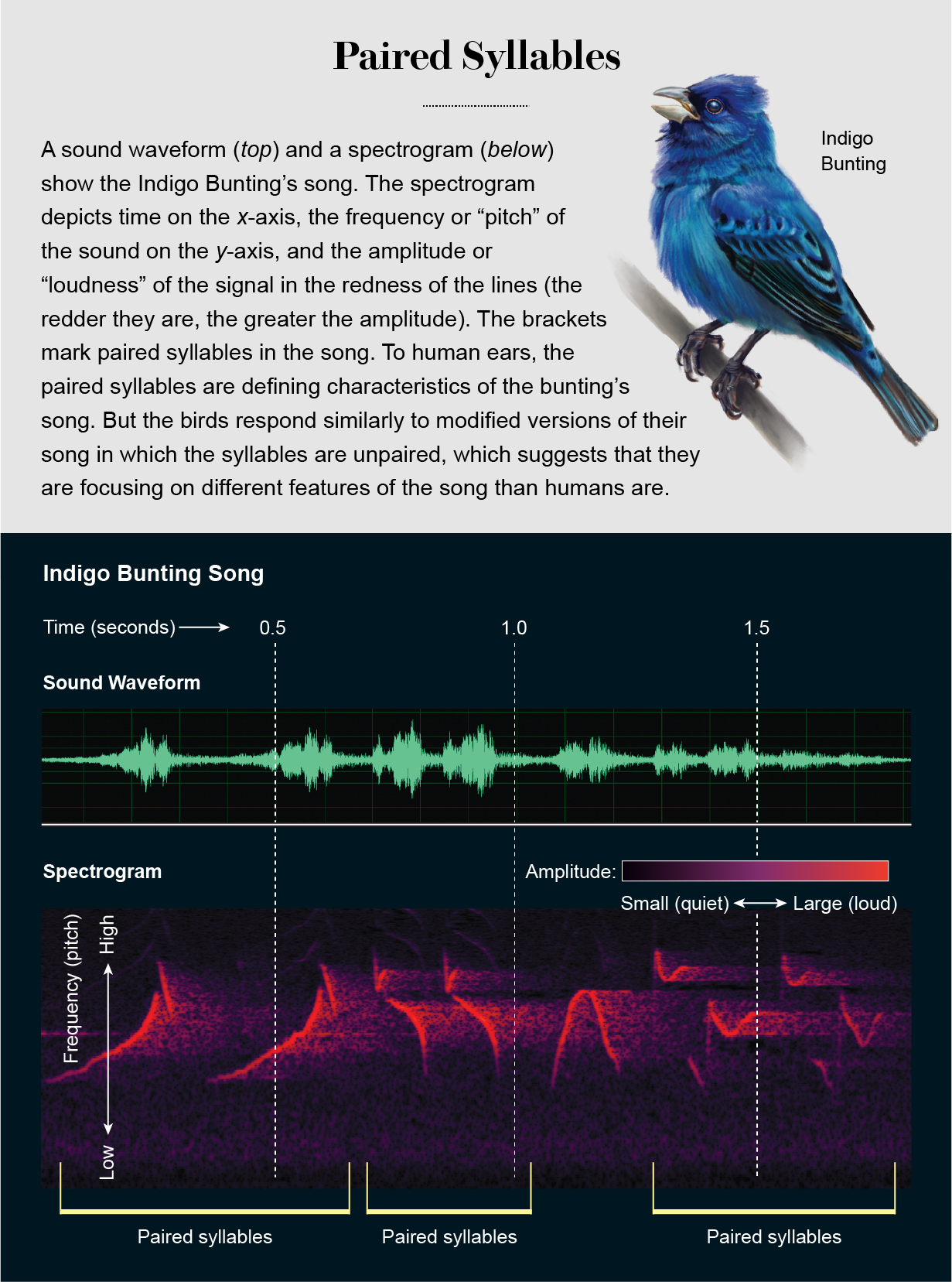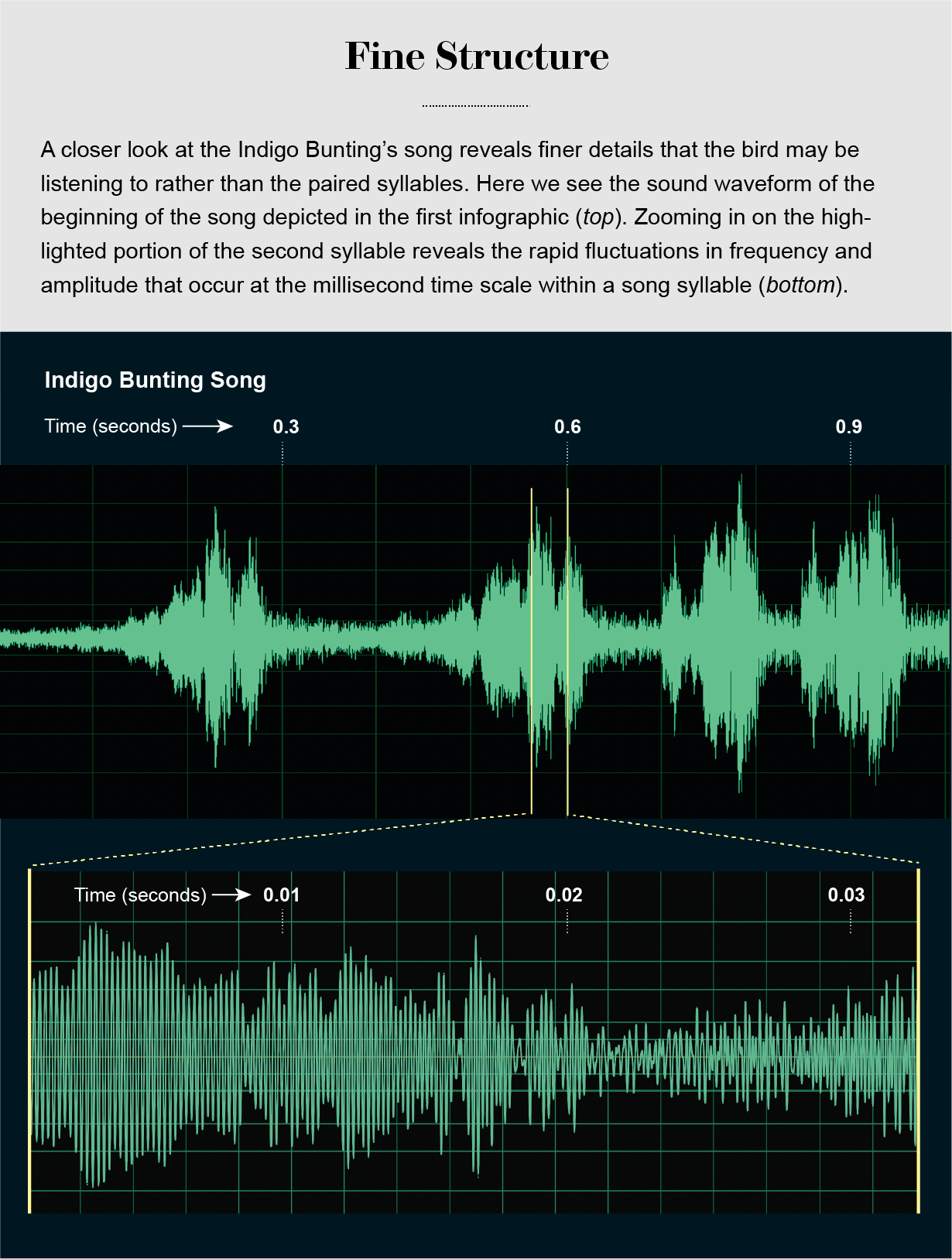
what this reveals is that the tune we hear is almost a carrier wave packing plenty of usable detail which we miss. I wonder if this happens with Orcas? Or fish?
We also know that intelligent animals can project thoughts mind to mind. It is plausible that less intelligent creatures only lack the range needed to be noticed.
We really need to repeat these tests with mice in particuloar and all else as werll. We also need to produce a proper mind to mind test that determines actual range. Again we do have mice and rats to work with.
What Birds Really Listen for in Birdsong (It’s Not What You Think)
Birds seem to pay more attention to fine acoustic details that humans cannot hear than to the melodies that captivate us
Australian zebra finches. Credit: Tim Flach
https://www.scientificamerican.com/article/what-birds-really-listen-for-in-birdsong-its-not-what-you-think/
When we humans hear birdsong, which many have appreciated more than ever during the pandemic, we can’t help but think about parallels to human music and language. We discern distinct melodies linking the clanks and buzzes of Song Sparrow songs, sentencelike structure in the Red-winged Blackbird’s pronouncement of conk-la-ree! and a cheery whistle in the wide-open-beaked songs of the White-throated Sparrow.
Birdsong, which has intrigued scientists since Aristotle’s time, is traditionally defined as the long, often complex learned vocalizations birds produce to attract mates and defend their territories. Modern researchers categorize it in contrast to bird calls, which are usually shorter, simpler, innately known and used for a more diverse set of functions, such as signaling about predators and food. These definitions are by no means clear-cut. For instance, some species have songs that are simpler than their calls. But when I refer to birdsong, I mean those longer, more complicated sounds as opposed to the short cheeps and peeps.
The very terminology researchers and laypeople alike use to talk about birdsong reflects the musical and languagelike way it strikes our ears. Getting deeper into the lingo for a moment, when researchers analyze birdsong, we usually break it down into smaller units, termed notes or syllables. We then group the syllables into sequences called phrases or motifs that have characteristic rhythms and tempos. In this way, we can measure potentially important aspects of song, such as the number of syllable types in a bird’s repertoire or the patterns in which phrases are arranged. These descriptions also parallel the ways we mark the relations among words in human syntax or among notes in musical compositions.
But what do the birds think about all these features? How does birdsong sound to them? Recent research that my colleagues and I have conducted, along with work from a growing number of other scientists around the world, has revealed that birdsong sequences do not sound to birds like they do to us. Moreover, birds appear to listen most closely not to the melodies that catch our ears but rather to fine acoustic details in the chips and twangs of their songs that lie beyond the range of human perception.
BEYOND MELODY
Birdsong researchers have known since at least the 1960s that birds hear song differently than we might expect. One of the classic ways to test perception in birds in the wild is through so-called playback experiments, in which investigators play songs to birds and measure their behavioral response. Many birds respond to playback of a typical song of their species as if a territorial intrusion were occurring—they approach the speaker from which the song is playing, fly around the sound’s source to look for the intruder, and emit their own threatening calls or songs. By comparing responses to natural and manipulated songs, researchers can learn which features are important in perception. In the predigital age, they would capture song on tape recorders and literally splice together the magnetic tape to create manipulated songs with, for example, rearranged syllables or shorter silent intervals between notes. Today digital recording equipment and sound-editing software make such manipulations much easier to create.
In one classic playback study in the 1970s, Stephen T. Emlen of Cornell University studied song perception in the Indigo Bunting. The vibrantly blue males of this species deliver songs consisting of syllables that they almost always utter two at a time. Ornithological field guides often call attention to this pattern of paired syllables when describing the song, and it is easily seen in a spectrogram, a visual depiction of song that shows the frequency and amplitude of its signal over time. (The perceptual equivalent of frequency is pitch, and that of amplitude is loudness.) Despite the prominence of the paired pattern to human ears and eyes, when Emlen played a modified song with unpaired syllables to the birds, they reacted with the same intensity of territorial response they exhibited when they heard the natural paired song. This result means that, despite its salience to us, the pattern of paired notes is not significant for the birds in terms of recognizing fellow species members. If the Indigo Bunting were to write a field guide description of its own song, it would differ considerably from our assessment

Credit: Liz Wahid (Indigo Bunting) and Adam Fishbein (waveform and spectrogram)
Testing how birds perceive song in the wild is important, but it has its limits. A bird could be out of earshot looking for food when you want to start your experiment, for instance. In the laboratory, researchers can test hearing in birds with more precision and control. When you go to the doctor’s office and have your hearing checked, you are instructed to raise your hand or push a button to indicate that you’ve heard a sound. Researchers use a similar approach to probe auditory perception in birds. Because we can’t explicitly ask the birds, “Did you hear that?,” we train them to peck a button on the side of their cage if they detect a sound or if the sound they hear fits into a particular category or differs from another sound.
Lab studies have found many similarities in auditory sensitivities between songbirds and humans, including the thresholds for hearing differences in pitch or detecting gaps between sounds. But they have also revealed surprising differences between the abilities of birds and humans to hear sequences of sounds and acoustic details.
One pivotal finding from such work is that birds perform surprisingly poorly on recognizing a melody shifted up or down in pitch. This is something humans do naturally: we still recognize the tune of “Happy Birthday to You” if it is played in higher or lower registers on a piano. Classic lab experiments in the 1980s and 1990s by Stewart H. Hulse and his colleagues at Johns Hopkins University showed that for birds, when the pitch of a sequence changes, the tune sounds different, even though the underlying pattern remains the same. Thus, the melodies we hear when we listen to birdsong may be very different from the birds’ perceptual experiences.
Subsequent studies have bolstered that hypothesis. In 2016 a team led by Micah Bregman, then at the University of California, San Diego, reported that European Starlings can recognize transposed sequences but only when all the fine details in the sounds are removed. That work highlights the importance of those fine details to birds when listening to song.
AN EAR FOR DETAIL
You can break a sound waveform down into two levels of description: envelope and fine structure. The envelope is made up of slow fluctuations in the amplitude of the waveform, whereas the fine structure consists of the rapid fluctuations in frequency and amplitude within the waveform. In other words, a sound’s fine structure is how it changes at the millisecond level. Historically, many birdsong researchers overlooked fine structure, in part because it is not readily visible in sonograms or spectrograms, which have been useful in helping people visualize song. But zooming in on the waveform of an individual song syllable can reveal these fine acoustic details.
Robert Dooling of the University of Maryland helped to pioneer the study of fine structure in birdsong. For decades he and his colleagues have been working to assess birds’ ability to detect it. In a pivotal study published in 2002, they tested birds and humans on distinguishing sounds that differed only in fine structure. All the bird species they tested—Zebra Finches, Domestic Canaries and Budgerigars—performed much better than the humans did. The birds were able to hear differences in fine structure two to three times smaller than those the human subjects could detect. The exact physiological mechanism underlying the birds’ superhuman sensitivity remains unknown, but it may be related to features of their inner ears, which differ from our inner ears in having a relatively shorter cochlea that is slightly curved rather than coiled.

Credit: Adam Fishbein (waveform and spectrogram)
When I began studying how birdsong compares with human language in 2015, when I was in graduate school at the University of Maryland, I wasn’t thinking much about fine structure. Instead I was looking to uncover languagelike grammatical abilities in birds. But as I dug deeper into this question and conducted many experiments with birds, I came to realize that the key to understanding what they are communicating in song may lie in these fine acoustic details rather than the sequences in which they occur.
The grand champion of the birds tested in Dooling’s 2002 study was the Zebra Finch. This small, lively songbird native to Australia is the most popular species for lab-based modern birdsong research, largely because it both sings and breeds prolifically in captivity. Its song, produced only by males, is also relatively simple, consisting of a single motif of three to eight syllables repeated over and over again, usually in the same order. The simplicity of the song makes it more straightforward to study than others. Because the males learn both the syllables and the sequence in which they occur from a tutor, typically their father, one might think that both levels of the song are important in perception.
We tested that notion in a 2018 study that examined how well Zebra Finches hear the difference between natural song motifs and motifs where syllables are either temporally reversed or shuffled in sequence. We trained birds to report whether they could hear the difference between sounds. They listened to a repeated sound and then pushed a button to initiate a trial where the sound either changed or remained the same. If a bird pecked a certain button when the sound was different, it counted as a correct hit, and the bird got a food reward. If it pecked that button when the sound was the same, the lights in the chamber went off, and it counted as a guess. Using this method, we evaluated the birds’ ability to discriminate between the repeating sound (the natural song motif) and novel sounds (motifs whose syllables we had temporally reversed or shuffled). From the birds’ perspective, they were simply trying to earn tasty food.
Interestingly, the Zebra Finches performed nearly perfectly at discriminating reversed syllables, which can be difficult for our human ears to detect, but they did poorly at discriminating shuffled syllables, which are more salient to us. When you reverse a syllable, one of the main things that changes is fine structure, so it is not surprising that the birds knocked it out of the park on that exercise. Yet their difficulty with sequence differences is unexpected, not only because those changes are easy for humans to hear but also because the males learn to produce song syllables in particular sequences. Their difficulty in perceiving shuffled syllables may mean that for these songbirds, sequence matters in the learning process but does not carry much information for communication.

European starling. Credit: Tim Flach
Given the results of these experiments with artificially modified songs, my colleagues and I began to wonder how fine-structure perception is relevant for natural song communication. Hearing reversed syllables is impressive, but the birds never actually produce such sounds. So the next question we asked was how well birds hear subtle natural acoustic changes in song.
My colleagues had already shown in another 2018 paper that Zebra Finches can hear tiny differences in the fine structure of one another’s calls, which can carry information about sex and individual identity. To examine their perception of fine structure in song, we took advantage of the fact that Zebra Finch song bouts consist of a single motif repeated over and over with the same syllables in the same order—or at least researchers think of them as the same. In truth, there are small differences in how a given syllable is uttered in each rendition of the motif. We tested the finches’ ability to discriminate between different renditions of motif syllables and found that the birds can hear the differences easily.
This result means that although to us the Zebra Finch song sounds like the same motif on repeat, to the birds it does not. We suspect that instead they could be perceiving a rich trove of information about emotion, health, age, individual identity, and more in the fine structure of song beyond what our ears can detect. It is reasonable to expect that other birds with songs that sound repetitive to human ears share the Zebra Finch’s powers of perception.
You might be wondering whether these small acoustic fluctuations in song are just accidental or random, like variations in the trajectory of a pitcher’s curveball toward home plate. In fact, the key to fine structure may be the avian voice box. Humans produce the sounds that we shape into speech with our mouths and tongues using a single source at the top of our neck, the organ known as the larynx. Birds, in contrast, produce sound using a unique two-branched structure that sits atop the lungs called the syrinx. It carries two sources of sound, one from each branch, that can be controlled independently. On top of that, muscles in the songbird syrinx contract faster than any other vertebrate muscle, enabling millisecond-level temporal control. Thus, the birds aren’t producing fine acoustic variation by a slip of the beak—they can control it in addition to perceiving it.

Credit: Liz Wahid (Zebra Finch) and Adam Fishbein (waveform and spectrogram)
DANCE OF THE SYRINX
Together these studies show that birds listen to song differently than we have traditionally imagined. Melodies and sentence structure are essential to us when we listen to music and speech. We can’t help but project them onto birdsong when we hear it. But differences in sequence don’t seem to matter much to birds. Some species have difficulty hearing even simple changes. For humans, when these kinds of manipulations occur in speech or music, they totally disrupt the message or melody. But birds seem to be listening most closely to the acoustic details of individual song elements, independent of the sequence in which they occur. And they hear details beyond what our ears can discern.
In thinking about how birdsong sounds to the birds, a better analogy than human language or music might be dance. When we learn a dance routine, getting the sequence right is necessary for getting the moves right—like when I learned to follow a Lindy Circle with a Charleston in my swing dance class. Screwing up a transition can cause the structure of an individual move to fall apart. But someone watching a dance does not extract much information from the order of the moves. Instead the audience is focused on the acrobatics, rhythm and variety of the movements rather than the sequences in which they occur. It may be the same for birdsong. From the perspective of the bird producing the song, getting the sequence right can be essential for getting the “moves” right. But for the bird listening, what is most important may be the individual moves themselves.
\

Budgerigars. Credit: Tim Flach
This is not to say there aren’t certain significant parallels between birdsong and human speech or music. The ability to take heard sounds and reproduce them as humans do in speech and birds do in song, a feat termed vocal learning, is actually quite rare in the animal kingdom. Our closest living relatives, chimpanzees, do not appear to be vocal learners, nor do any other primates. Even those mammals that do show some vocal-learning ability—bats, whales, elephants, seals and sea lions—do not achieve the same level of vocal mimicry as humans and some birds (songbirds, parrots and hummingbirds, to be specific; other groups, including pigeons, chickens and owls, are not vocal learners). Even more amazingly, researchers such as Erich Jarvis of the Rockefeller University have shown that similar neural pathways and molecular mechanisms control vocal learning and production in songbirds and humans, a product of convergent evolution. In this way, we can learn a lot about human vocal communication from studying birds. But the songs they produce do not appear to be the music or language to their ears that we might imagine.
We still have a lot to learn about how birds perceive birdsong. Several studies have shown evidence that bird calls convey specific information about things in their environment such as food or predators, but we do not yet know whether anything similarly meaningful exists in birdsong, perhaps carried in the fine structure. Neither do we know how birds perceive the fine structure of song in natural environments, where sound can bounce off trees and buildings and has to compete with a cacophony of environmental noise.
Additionally, recent work has shown that, contrary to traditional views of birdsong as a strictly male behavior, female birds commonly sing, too. This discovery raises the question of whether male and female birds may listen to song differently. Moreover, in many tropical species, male and female partners sing highly intertwined duets that can even sound to human ears like a single continuous song. How do birds manage to listen for their turn to sing while making sure to produce the correct notes?
The next time you hear a birdsong, try thinking of it less like a catchy melody or a simple sentence and more like a fast-moving, precisely coordinated dance of the syrinx—one that’s potentially as rich in emotion and meaning as human language or music but expressed in a different way.
No comments:
Post a Comment